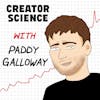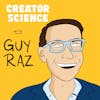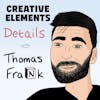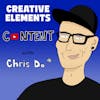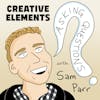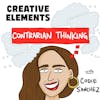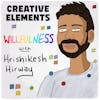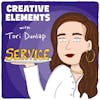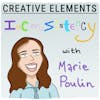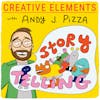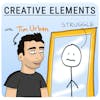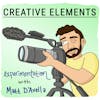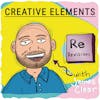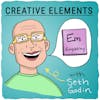
#169: Q&A With Jay – What to create, when to focus on growth, and what I’m dismantling.
Play Episode80 minutes answering questions from listener like YOU.
This week we are back with another listener Q&A.
I took questions from a lot of different sources this week and will answer as many as I can.
I'm going to start with the questions that I got from readers of my newsletter, then I'll go to questions from The Lab, Twitter, LinkedIn, and Threads.
Listen to my recent Mailbag episode
Full transcript and show notes
***
CONNECT
📬 Subscribe to Creator Science
🙏 Make a guest or mailbag request
📝 Check out our curated Playlists
***
SPONSORS
💼 View all sponsors and offers
***
SAY THANKS
💜 Leave a review on Apple Podcasts
Learn more about your ad choices. Visit megaphone.fm/adchoices
Jay Clouse [00:00:14]:
Hello, my friend. Welcome to another episode of Creator Science. We are back with a listener q and a episode this week. Thank you to everybody who follows me, in other places online, in the newsletter, YouTube, social media. I took questions from a lot of different sources here this week. I'm gonna run through a lot of them. I'm recording this on Sunday evening right now. I've been, watching NFL red zone all day.
Jay Clouse [00:00:42]:
Anyone out there who's a NFL fan, red zone is just one of the best parts of the year in the NFL season. So I got to spend some time enjoying that today. I also negotiated a 50% off price on a lawnmower at Lowe's So I am riding high. It's been a good day, and I'm excited to dig into some listener questions here. We are just gonna get right into it. I'm gonna go for as long as I can. I have More questions than I can get through, but I'm gonna go through a bunch from here, starting with questions that I got from readers of my newsletter. If you do not yet subscribe to the Creator Science newsletter.
Jay Clouse [00:01:18]:
Please take a moment to do that. I highly highly recommend it. If you like the show, you'll like the newsletter. Just go to creator science.com to subscribe. It's Free. I send out 2 per week, one that's inspired by this podcast and another that is just a long form essay that will help you become a professional creator. We're gonna start with some questions from Steven Harris. He has a few here.
Jay Clouse [00:01:39]:
They're kind of rapid fire, so we'll go through all 3. Steven asked, what is the most Cost effective way to grow a weekly mindset newsletter. Well, the most cost effective way is to not, Have costs in terms of cash at all. I would say right now, we are seeing something magical in the world of email newsletters, and that is recommendations. We see it through ConvertKit's creator network. Beehive has a rec a recommendation function. Substack actually innovated the recommendation function. So, really, the best way, in my opinion, to grow any newsletter right now is by being on either ConvertKit, Beehive, or Substack and taking, taking advantage of their recommendations features because you can build relationships with other newsletter operators.
Jay Clouse [00:02:25]:
You can send them subscribers. They send you subscribers. Right now, I am picking up something like 700 subscribers per week Through ConvertKit's creator network, it's highly effective. It's the fastest I've ever grown. And, yes, it will take some work and building relationships and kind of forging these alliances if you will but it's worth it because this Creator Network effect is disproportionately growing my list compared to all other sources combined. Steven also asked what strategies do you use for inspiration to keep a list of topics flowing? When you sign up for the Creator Science newsletter, there is a 2 email welcome sequence, and the 1st email asks One question that says, if I were to dedicate an issue of this newsletter to an issue you are currently facing, what would that be? And so literally every day, I get readers who subscribe for the 1st time who respond to that email and answer that question. And if they don't answer that question, The 2nd email says what's going on in your world that led you to sign up for this list? So everyday I'm getting multiple email responses giving me ideas of what people are looking for but I also get you know a lot of questions to my social media when somebody replies to something that I tweet or put on Instagram or whatever that is all inspiration for okay if this person's taking this maybe other people are you might start to see some patterns. You might say, I've heard from 4 different people something about this question.
Jay Clouse [00:03:49]:
I should probably create something around it. And then Steven's last question was what would you say is the ideal word count for the average reader? I haven't thought about this too deeply. I would say the the typical essay that I write for creator science is somewhere north of 1500 words I saw Sam Parr give some advice less than 500 words or more than 1500 words should not be in the middle and I the more I think about that the more I think it's true you should either go short or pretty dang long you don't want this kind of medium length because then it feels like it either should have been shorter Or it should have been more in-depth. It's kind of a weird area. So I'd say less than 500 words or more than 1500 words is is a good rule of thumb. Alright. Next, we have a question from Brian Kofsky. He asked, how do you manage reporting across multiple platforms? Can you share the KPIs you focus on the tools you use your reporting cadence and how much of this process is automated well what Brian doesn't know probably is that I actually do a KPI tracking process every month.
Jay Clouse [00:04:57]:
And that's part of the monthly retro that I share in the lab, my membership community. Every month, I track my KPIs for the month. I share a 30 minute video walking through those KPIs, my whole profit and loss statement, and some decisions I'm making because of it so I do that on a monthly basis and unfortunately it's still a very manual process I have a Google Doc spreadsheet that I've been keeping for the last 2 years and it has a whole bunch of categories I will let me just open up what those KPI's are so I track revenue based on all of my streams of income so I'll track digital products revenue and I'll even break that down into courses and workshops I track affiliate revenue membership revenue services revenue royalty revenue Sponsorship revenue across the newsletter and spark loop and the podcast and YouTube AdSense I track all my costs as well breaking down in things like advertising, contract labor, payroll, memberships, travel, tools. Then I track the growth the follower growth on different, social media platforms, Twitter, LinkedIn, Instagram, threads, TikTok. I track a bunch of metrics on YouTube including subscribers how many were gained in that month gross growth percentage Adsense revenue views click through rate on average average view duration number of email subscribers website visitors Podcast download. So it's it's a lot. Now Brian asked, how do I manage reporting across those Platforms. Those are the KPIs I focus on.
Jay Clouse [00:06:38]:
The tool I use is Google Sheets. I do it once a month. It's not automated. What I do is I just go into the different platforms I look and I on the 1st of every month I say how many followers that had all these platforms I will do my bookkeeping in QuickBooks every month and so that's what really gives me the breakdown of revenue and costs but other than that I go to all these different platforms including YouTube do a query on the previous month and pull that all out and it's a it's takes some time probably takes me 1 or 2 hours once a month to fill out that spreadsheet and then you know another hour to prepare and record the retro that I do in the lab Ben asked a really great question. He says, I've been writing a newsletter for several weeks now, and I swing between writing about stuff I wanna write about and what I think my readers want to hear about. So my question is, how do you find the balance between experimenting with topics versus doing what you think the audience will like? Given that I'm new to this, I'm thinking that writing about the what the audience will like is dangerous Because it might not be the audience I actually want to attract and I would say ding ding ding that is correct. The way I think about this between you know writing what you wanna write about and writing what you think the audience wants to hear about you want alignment there you want the audience to also be interested in the things you want to write about and so this is a little bit of a it's a little bit it's not quite a catch 22 like I think what you should do is You know, think critically about the things you wanna write about and ask yourself, is is there an audience there? Is there a business there? Is there a market there? And if so, Write about the things you wanna write about because that's going to attract people who want to hear about those things, read about those things. When you track people who want to read about the things that you want to write about, then you have this perfect amazing alignment where you continue to write about the things that you wanna write about.
Jay Clouse [00:08:25]:
Now there is an important caveat here which is you can't just be all over the board like we are complex creatures we have complex interests a lot of times I wouldn't recommend you know indulging A bunch of different discrete unrelated interests in 1 content platform because It's unlikely that there's gonna be a large audience of people who have the exact same intersection of varied interests that you do. So, Yes. You wanna write what you want to write about, but it needs to be fairly focused, you know, related so that the typical reader you're attracting is going to continue to be interested in that thing and doesn't require them to have the same intersection of, you know, a ton of different interests. The last question I took from newsletter responses is from Trevor And I guess it's probably worth noting that this invitation to reply with questions came from a newsletter issue about discovery platforms versus relationship platforms. Relationship platforms are decentralized utilities like email podcasting SMS and private communities discovery platforms are Social media, YouTube, Google search, things like that. That context is important for Trevor's question. He asked, for a video creator's first post on a discovery Platform. I'm guessing he's talking about YouTube here.
Jay Clouse [00:09:48]:
Do you recommend posting a few videos at once to have more content for people to watch and maybe more algorithm traction? I'm glad Trevor asked this question, and I kind of want to put it to bed. Okay? Back in the day this is where I think this comes from. Back in the day, when podcasts were a new thing, it became common advice to say, when you launch a podcast, you should launch with 3 episodes. And the reason people said that was because back in the day, iTunes, New and Noteworthy, was an important part about podcast discovery. It could literally Lift your podcast out of obscurity overnight and it was, kind of, algorithmic In that, if you release a new show and it got a lot of downloads quickly relative to the rest of the podcasting world, then it would get picked by new and noteworthy because it was new and noteworthy because people were listening to it. So the advice was release multiple episodes because if you're driving your audience to the show for the first time Instead of getting 1 download per person that you send to your show, when they subscribe, they'll download all 3 and that's 3 downloads. And that makes it more likely that you will Get an algorithmic boost from iTunes new Noteworthy and make it onto that platform. Now, not only is this not true and it's It hasn't been true for a long time.
Jay Clouse [00:11:04]:
Apple's new and noteworthy is now an editorial decision. It's not some system that you can game and also back in the back in the day when this was doable there were far fewer podcasts there was not much competition. It was an easy system to game that just doesn't exist now. So I think there's still this belief though that, hey, when you publish something for the 1st time, you should publish multiple things because then people have lots of things to watch, And it might give you some algorithm traction like like Trevor's question here. I don't think that's true, and I wouldn't recommend it at this time, to be honest. I think, if I was starting on YouTube today, I would release 1 video and then release the 2nd video after a period of days or even a week if you want to be kind of regular on the platform. There's another interesting interesting thing about YouTube though most of the time people advise that you are very consistent in your schedule that you publish and for most platforms it makes sense because there is evidence to say to suggest that when you are consistent on platforms, the platform learns your schedule is more likely to boost your stuff because it sees you as active. I don't see that evidence on YouTube.
Jay Clouse [00:12:12]:
What I see on YouTube is that it's highly competitive and quality matters a lot, and it's more important to have a high quality video and publish infrequently or irregularly than to be consistent with a schedule so if I was starting on YouTube today, I would make the best video I can post 1 at a time, see how the audience, the algorithm reacts to it, And then, you know, experiment with every single video you publish. Something that we do when we release a video After about 24 hours of being out you can look at the retention curve you can see did we lose people quickly Where did we lose people? And you can try to make your next videos more retentive because more retentive videos means a higher average view duration more time on platform you're probably gonna have a more successful video so I would release 1 at a time be very data oriented with those videos and get a little bit better each time Trevor had a follow-up question for a video creator specifically says, what tactics do you recommend to get people to sign up for emails from you, like, mentioning them at the start of the end of videos or posting description, etcetera? This a good question. I don't think that I've done this very well. For context, we just had a a video on the channel that By the time you listen to this, it might be crossing a 1000000 views. And we saw a boost in subscribers but I don't really have a clear call to action or system for telling viewers Hey I have a newsletter go find it it's it's in the description it's on the about page of the channel And people do find it increasingly more people responding to my welcome sequence tell me that they found me on YouTube. So I know that it's really playing a great job of top of funnel but I haven't really created a good system here now someone who does this very well in my opinion is Ramit Sethi He does it with his YouTube channel and his podcast which is the same product just one is audio only throughout his episodes He will cut in and say, hey. By the way, I actually have a free budgeting template for you. Just go to I wt.com/template.
Jay Clouse [00:14:22]:
You know, something like that. I think that's the smartest way to get people to sign up for emails is to have some clear thing in your video stay with me. Some clear thing in your video that, is a resource or something that you talk about that people say, oh, I want that. And then say by the way I've made a free version of this or a templated version of this or a resource around this you can get it for free by going to this website.com when you direct people To get a thing that relates to something you just made a compelling case about in the video, I think it does very very well. Alright. Those are the questions that I pulled from people responded to the newsletter. So thank you guys. If you had your question answered, thank you.
Jay Clouse [00:15:04]:
Thank you. Thank you for submitting it. Again, if you have not already subscribed to the Creator Science newsletter, I really recommend you do so. Just go to creator science.com. Next, we're gonna move on to answers from YouTube I've been making taking more advantage of the community tab in YouTube I'm enjoying it we have a growing audience there we'll we'll cross 40,000 subscribers on YouTube here in the next day or so. So I've been feeling a lot of love there getting a lot of questions there. The next question comes from Melvin who's also a member of the lab shout out to Melvin. He says, how do you think about when it's time to grow versus time to stabilize and let systems catch up look for inefficiencies etcetera.
Jay Clouse [00:15:43]:
I love this question and I'm going to answer it after a quick break for our sponsors. Alright. Welcome back to our listener q and a episode. As a reminder, this is a question I read from Melvin from YouTube. Melvin asked, how do you think about when it's time to grow versus time to stabilize and let systems catch up, look for inefficiencies, etcetera? So I believe a lot in momentum. And momentum is something that's hard to get going but once it gets going it's difficult to stop you know think about Something heavy that you're trying to roll. Stick with me. Trying to roll something heavy, and we'll say that the ground is flat.
Jay Clouse [00:16:23]:
It's difficult to get the thing rolling. But once it's rolling, it's difficult to slow it down. So the way that I often think about growth And when it's time to lean into growth is when I feel momentum because, again, it's just hard to get going. When you feel momentum in some area of your business, I think of that, about this phrase my dad would say growing up. We we lived on a farm and he would say, you gotta make hay while the sun is shining. And the idea was You don't know when the sun is gonna be shining, but when you have a sunny day and things are looking well, that's the day that you gotta go out there and Make the most of it. Okay? And I think of momentum as the sun is shining, it's time to make hay. That's really what I try to lean into.
Jay Clouse [00:17:06]:
If things are kinda stagnant not growing a lot it's frustrating and your instinct is to work to build momentum but I think that's actually a really good time to reflect think about you know what systems could I improve where inefficiencies and these are great things because these are great things to identify because even when you have momentum you often recognize oh I I I'm lacking some systems and I have some inefficiencies here but I don't think you wanna pause that momentum to fix those things I think you wanna make hay while the sun is shining and instead look to catch up with your infrastructure when things feel a little bit slow because then there's there's less of an opportunity costs and also at that point you clean things up it's gonna make it a little bit easier to try and get momentum rolling anyway Next question comes from Ryoga Hibiki. They said a lot of traffic onto our podcast comes from having guests on the show, but we never get the same traction when it comes from doing podcasts on our own? How can we get audiences to come back and listen to our podcast rather than just coming to listen to our guests and not returning? I think, in general, we overestimate the impact of guests on our show. I actually think right now in podcasting, whether it's audio or video, the fastest growing, easiest to conjure opportunity for growing a podcast is having a co hosted show because then you have this instant friendly rapport people like listening to a podcast where they feel like they're listening in with friends because it's a very personal medium and it feels like you are with your friends as well The difficult thing about having guests is a lot of times you've never met that person before. It's difficult to have that same friendly report. It can feel a little awkward. People listening could have secondhand embarrassment and awkwardness so having a co hosted show is a gift and if you you know I'm reading the language of this question it sounds like there's multiple people involved in this team I think the opportunity here is actually not worrying about the guests as much getting people to come for you. And so here's what I think might be happening for you. I think a lot of podcasts, especially on YouTube, they depend on the guest as the crux of the package right if we think about packaging its title its thumbnail it's the idea inherent in this thing think a lot of podcasts on YouTube, their whole package is just constructed around the name or personality of the guest.
Jay Clouse [00:19:42]:
You know? I had, Guy Raz on my podcast, and we kinda constructed the package of that around Guy's name. When you do that the people who come to the video are people who are interested in that person that's why they're there so they're not gonna be all that interested in you they're coming for that person what we've begun doing on the channel you can see this in our recent video it's blowing up with Jenny Hoyos we now package the episode around the idea of the interview one idea that we go deep on rather than the person and so you know instead of saying Hey here's my interview with Jenny Hoyos we said here is how this person solved shorts you don't have to know the person's name you you have to be interested in shorts instead and so you're not joining for Jenny you're not joining for me you're joining to get that insight, get that information, have that experience. And because you're not primed to value the guest more than the host, I think a lot of people come to our episodes now they start to develop a relationship with me. And so, you know, they'll subscribe put out another video and they trust that I will make it worth their while it's a slow burn building trust with any audience is a slow burn but I think it starts with your package being more about the idea the idea that you are bringing to life and less about the guest name or the guest face. Kyle Granger asked, what's most important when interviewing a guest? Tailoring the questions to serve their audience or ensuring the questions will be relevant to your audience? This is a good follow-up on the last question, and I think the obvious answer is, obvious to me, not obvious to you, Kyle. I'm not blaming you for asking the question. I think the obvious answer to me is tailoring the questions to be relevant to your audience and not even just your existing audience but your aspirational audience is another myth I think that comes from having guests on your show. We think that by having some big name or some known person, their audience is gonna flock to us, and that's how we grow.
Jay Clouse [00:21:41]:
And in my experience, just doesn't really happen that way. A lot of times these people have so much recorded content out there that their audience isn't just flocking to every single interview they do and a lot of times that guest doesn't share the show either so I wouldn't tailor it to their audience I would tailor it to yours and I actually think that there's big opportunity by exploring new ground that this person doesn't often talk about. So if you intentionally tailor it to, you know, what their audience hasn't heard before by tailoring it to your audience, then that is, I think, a really smart strategy. But, ultimately, you know, your your duty is to your people, your audience, your viewers. So I would do whatever you can to do right by them and tailor your questions tailor that experience with that guest to be relevant to your audience. Alright. Next we have Justin who asked if you were a personal injury lawyer Justin is a personal injury lawyer. He says would you interview on your channel outlier injury lawyers who get, you know, crazy results similar to what I'm doing on my YouTube channel.
Jay Clouse [00:22:49]:
Let me let me rephrase that. He's saying, hey, Jay. On your channel, you interview creators who are getting outlier results should I do that as a personal injury lawyer also interview personal other other personal injury lawyers who are getting outstanding results and really it comes down to what you want the channel to do for you, Justin it comes down to why do I have this channel because if you interview other personal injury lawyers who have exceptional results that's gonna draw viewers who are really interested in learning from excellent personal injury lawyers it might not get you clients you know because you are As an interviewer, a lot of times, you are kind of, by default, placing yourself in a secondary position in the viewer's mind. You know you're you're like shining a light on this person like this is the subject this is the person we're coming to learn from and you take a back seat a lot of times so if you are trying to get clients then I don't think that's putting you into the the right position that you want. It really comes down to what you're trying to achieve on your channel. And as I said, I I think guest a guest strategy on a podcast is hard. I think a podcast strategy on YouTube is hard. So really, If you have a podcast on YouTube, I think you have to ask yourself, what is the goal of having this channel? Is it clients? Is it growing my own status? I think it's a lot easier to grow a channel not based around long form podcast to be honest.
Jay Clouse [00:24:23]:
I think it's I think it's good to do solo videos with interesting packages that you have control over they're they're well produced Most people will not go to the lengths that we do to make remote interview podcasts really visually interesting. We truly, truly, truly Think we're doing some of the most innovative best work on YouTube for remote interview podcasts, and it takes a lot of work. It takes a lot of expense. Most people aren't willing to do that. And if you're not willing to do that, you're doing the minimum to record remote interviews on YouTube. It's not gonna be very visually interesting. You're not gonna get a lot of results. You're probably better off doing solo videos or doing a co hosted show where there's, you know, rapport between you and a friend so short answer your question Justin I don't think I would recommend that strategy unless you are really just trying to elevate you know the personal injury lawyer field I guess comes down to your your goals and I don't know your goals so it's hard for me to answer that question any more specifically than that.
Jay Clouse [00:25:29]:
Alright. Jon Coon, who is a longtime supporter of the show. Thank you, Jon. I felt your support for a very long time now going back to when this is an audio only show he asked how do you develop self awareness as a creator in order to be able to objectively answer the question is this actually working and this is such a great question how can I objectively look at what I'm doing and know that it's working or not and he didn't ask this but I'm I'm assuming he's saying especially in the absence of signals sometimes or the absence of obvious signals I know there were times, you know, as early as 2 years ago I've been doing this for 6 years but even 2 years ago I often felt frustrated? I felt like I don't think this is working. It's hard it's hard to know. Something that I look for now you know I actually think back to the 2nd episode of the show I was speaking with James clear and he's talking about writing his book He said one of the hardest things about writing a book versus writing a newsletter is with the newsletter you publish you get immediate feedback from your audience He called the signals of progress. There are all these signals of progress when you're publishing something publicly frequently And in a book, he was saying he's basically in a cave for 5 years writing this thing. He doesn't get nearly that same type of feedback and data.
Jay Clouse [00:26:47]:
So as a creator and you're putting stuff out and you're asking, is this working? I think what you're looking for are signals of progress. Am I getting relative to where I was 3 months ago, 6 months ago, 12 months ago? Am I getting more feedback? Am I getting more positive feedback? If I'm not getting more, is at least getting more positive? One of the, words that I really look for And feedback I get from viewers or listeners or readers, I look for the word binge. And this is a new development. But when I hear people tell me, hey. I just found your channel, and I've been binging it. Or I just found your podcast, and I've been binging your episodes. To me that is a sign that there is product market fit the quality of my work is good enough to spread If it's good enough to binge, it's good enough for someone to share. If someone is bingeing your stuff, they're probably gonna share it with someone who has the same interests.
Jay Clouse [00:27:47]:
So I look for the behavior in my audience, the feedback from my audience to say, I'm bingeing this. You can look for other positive words. I think that's a pretty high bar if people aren't telling you they're binging your work yet, 1, I would continue to push the envelope of what you are capable of. Work harder to make the product better. But look at the feedback you are getting. Are you getting more feedback? Are you getting better feedback? If so, that's a signal of progress. Even if you aren't hitting the growth goals you want even if you aren't hitting the numbers that you want those are signals of progress that I would really believe in and maybe bookmark you know make a folder of people saying this because that's what keeps you going when you see this is exactly the type of person that I want to attract and serve they found it they love it that's a sign that you're doing the right things and you just need time Now again, what if you're not getting those signals of progress? Well, then you have some options. If you have conviction that you want to do this or conviction that your target audience needs what you're doing keep going make the products better and ask yourself This is this is a quote from, my 1st episode, Nathan Barry.
Jay Clouse [00:28:59]:
I think it was episode 96. In the early days of building ConvertKit, He spoke to a mentor of his, and the mentor says, have you done everything in your power to make this a success? Because if so, and it's not a success, it's time to give up. But I think a lot of us, we don't even come close to doing everything in our power to make something a success. So if you're not getting the the signs that you want, if you don't think things are working, You know, do you have conviction? If yes, have you done everything in your power to make this a success? If you don't have conviction, maybe move on to something else. If you've done everything that you can do, maybe try something else. But if you have conviction and you haven't done everything that you could do to make it a success, I would focus on making the product better. Last question that I'll take from YouTube. This is from Boston Speaks.
Jay Clouse [00:29:48]:
They ask, what is the biggest mistake you've made in your membership something has come to mind recently you know I I built this course called build a beloved membership I'm very proud of it I think it's the best course I've ever made if you want to build a membership I really encourage you to consider getting build a beloved membership because it is so good. I'm sorry. I don't say this about all my products. I really think this is so so good and it has the benefit of I was doing the membership and there were some things that I wish I had thought through earlier on so a huge part of that course is helping you think through the design of your membership to make sure that you're thinking long term okay because this is one of the bigger mistakes that I think I made in membership I did the math you know I built I built a spreadsheet it's in the course I built a spreadsheet that with some assumptions will tell you how much revenue you can generate from your course in the 1st month, the 1st 3 months, the 1st 6 months, the 1st year. And it allows you to toggle different prices. You can define different prices and that changes in real time, you know, the revenue potential of this membership. When I did this math, I landed on some numbers that I thought we're great. And that's where we are today.
Jay Clouse [00:30:57]:
You know, the the the base level membership with community access is $2,000 a year. And the VIP membership, which is The regular membership plus 2 hours of time with me throughout the year, that's $3,000 per year. And those numbers came from me running the math and saying, if I have a 200 member cap how much revenue if this is the only product that I do and that makes sense that is true what I didn't take into account though is business growth growth in my vision and what that would cost okay I think a lot about a conversation I had with my coach years ago probably 5 years ago I was covering my needs and now I said I'm gonna make 6 figures for the 1st time but I was having trouble hitting that mark and I didn't feel pressure to hit that mark so I said why can't I get motivated to hit this mythical six numbers figure and he said listen you're not motivated by money know that about you. I've worked with you. I know you're not really motivated by money in a vacuum. So he said, your You will earn more when your vision outpaces your resources. And that's begun to happen in the business. There are things that I wanna do, things I wanna accomplish that make my vision bigger, and I don't have the resources to do it.
Jay Clouse [00:32:19]:
1, I don't have enough time personally to do it myself. So to augment my resources my personal time I need to hire people talented people hiring talented people takes another kind of resource money So the lab it is my best performing products my most profitable you know best revenue generating product and I did the math to say if we cap out this will support me and my wife our family the business at the current state that it was but now there are things I wanna do I wanna hire a podcast producer for instance That was not in the plan when I did the math on the lab. And so I have effectively capped the earning potential of my highest earning product. And so the shortest distance between me today and me, someone who can afford hiring a podcast producer, is, selling more memberships, but I put a cap on it. Okay. So all this to say, Boston Speaks, my biggest mistake was not being more Forward looking at what an evolved version of the business might be. I did my budgeting and my planning based on current state and didn't think about the end state and I think a lot of people struggle with this in smaller ways you know they don't do the math at all and they say I'm gonna go out with a $20 per month membership they sell a 100 spots and it's still $2,000 per month and they think that's just not worth it for me to do this especially as more time passes you get more busy and you find other other ways to generate revenue suddenly $2,000 per month just isn't enough to keep your attention so I really think you have to be forward looking and planning you know what does this membership look like? How do I make sure that it continues to incentivize me to invest the time that I need to to make it great. Those were the questions from YouTube.
Jay Clouse [00:34:19]:
If you haven't checked out our YouTube channel yet, I really recommend you do. I think you would love the video episodes that we're putting out. All the video episodes we put out on YouTube have been on the podcast feed here, and you can watch the video on Spotify as well. But if you haven't checked out our YouTube, you should see what we're doing to make these episodes really visually compelling. Just go to youtube.com/ atcreatorscience y t or you can go to creatorscience.com/youtube. Find it there. Really recommend you check it out. Speaking of YouTube, Kyle Adams, another member of The Lab.
Jay Clouse [00:34:48]:
Hello, Kyle. He asked, you've been investing a lot of time and effort into YouTube. Do you feel like it's paying off? If so, in what ways is it paying off? And once again, I will answer this question right after one last quick break for our sponsors. Welcome back time to take this episode to the goal line we're moving on to questions from Twitter we got a lot of questions from Twitter The first one from Kyle. Once again, Kyle's a member of The Lab. So thank you, Kyle, for this question. He says you've been investing a lot of time and effort into YouTube. Do you feel like it's paying off? If so, in what ways is it paying off? I absolutely do feel like it's paying off.
Jay Clouse [00:35:22]:
I've invested a lot of money into YouTube over the last 16 months. Most of that in, Funding the team. We have, you know, Connor, our video editor. We have Jonathan doing thumbnails. We have Nathan doing audio. Izzy is my assistant. She helps with some things on YouTube. So all in, I probably invested close to 6 figures into the channel Over the last, you know, 16, 18 months, so it's it's it's a lot.
Jay Clouse [00:35:47]:
It's definitely still in, the red in terms of, you know, how much YouTube has earned versus how much I've invested into it to a very large degree, but I still do feel like it's paying off. I think that YouTube is actually where I'm going to see the most growth for the business overall in terms of reach we will see about revenue I'm still trying to figure some things out with revenue we have another question coming up about things I'm dismantling, and one of those things is my sponsorship strategy, because I think there's a lot more earning potential in YouTube and in our our sponsorship strategy generally so when I say it's paying off What I'm seeing is a trend a trend where the channel is earning more in the last 28 days YouTube tells me The channel has earned about $6,000 in AdSense. That's new. That's great. That, if that were to persist, That would make the channel itself sustainable, which is awesome. Now we're coming off the biggest month ever for the channel Where our episode with Jenny has almost a 1000000 views, so that's not really it's not likely to persist yet, But I see the potential. And like I said, when people join the email list, more and more people are referencing YouTube is where they found me. YouTube is leading to social media growth.
Jay Clouse [00:37:07]:
It's it's awesome. It's it's clear that it's reaching a lot of new people and a lot of people who I would love to know about my work both because they can be directly served by it, but also, like, members of the YouTube team have found me and followed me because of it. It's it's opened up a lot of really interesting doors and gotten my my name and face in the business out to a lot of legitimate people. I feel like I'm making strides into the industry the creator industry and in spaces that I haven't been before so I think it's paying off It's a ton of effort. That doesn't even you know, when I was talking about the investment that I've made into it, doesn't even count the effort. So much effort, so much time, But it's something that I'm going to prioritize even more highly in the coming year than this year. The next question is from Parker Worth on Twitter. I'm still going to Twitter.
Jay Clouse [00:37:57]:
I'm not gonna call it sounds weird it's from Parker on Twitter Parker's been a long time supporter has become a good friend over there he says how do you span to multiple platforms and keep your sanity. Also where do I get that Internet sweatshirt? If you haven't seen the Internet sweatshirt I have it's it's It's fun. I wear it in a lot of my interviews. I also wear it for a lot of my talks on stage. People love it. I wish I had made it, but it is, something jack butcher made at visualize value he had some for sale and it looks like the new version of the internet sweatshirt is a much better version also so If you get the new one, I will be jealous. Anyway, Parker's main question, how do you expand to multiple platforms to keep your sanity? It's really tough. And in fact, I recommend most people don't do it.
Jay Clouse [00:38:39]:
I am only simultaneously growing multiple platforms because I feel like I must based on my business. Let me explain. Creator science serves creators. Creator is a broad flexible term and the people who follow my work are creating on a lot of different platforms. They run the gamut. Email, YouTube, podcast, Instagram, Twitter, LinkedIn, TikTok. I feel to be credible to be legitimate and to serve that broad base of creators I need to have a working knowledge of all these platforms and ideally be pretty good at them too. I tweeted something today a lot of my Platforms are all converging around the same size like everything that I'm on is around 40,000 people Super unique.
Jay Clouse [00:39:30]:
I don't see other people who have done that most of the time people focus on 1 platform. They blow up they use that to leverage growth on other platforms. This is the playbook that people like Justin Welsh or Dickie Bush have followed. Justin grew really large on Linkedin Dickie grew really large on Twitter Justin and Dickie meet they realize hey, I want to grow on Twitter. I want to grow on LinkedIn. They help each other conquer the next platform because when you go into a new platform and you're starting from 0 one of the best ways to grow quickly is to basically have the support the endorsement the boost of someone else or somebody's else on that platform who have reach already that's how the game is usually played and that's how I recommend most people play the game get really good at 1 platform because then you have an asset to leverage you have your platform on that you know platform I keep saying the word platform you have your audience that is large on some platform that someone who wants to come on that platform a new you can say hey I'll get you out to my audience if you help me move on to this other platform and get me out to yours. That is the the way I would tell most people to go about expanding on platforms. And, yeah, I would just say don't expand to multiple platforms until you really feel like you've reached a point of saturation on 1.
Jay Clouse [00:40:48]:
It's so much more valuable to Saturate and grow as much as you can on 1 platform because then you have this asset to leverage I do go a little bit crazy being on multiple platforms because they're all so different they're such different games with different rules and to compete on any one of them you are competing against people who are focused solely on that platform it's you know it's as if you're saying like hey I want to go into the ring with one of the best boxers on the planet but that person's gonna train full time he's the best boxer on the planet he's gonna be training for this match full time I'm gonna fight him but I'm only gonna train halftime because I'm also going to try to get better at golf of course you're gonna get rocked like it's it's it's gonna be difficult for you to compete against that person And that's happening online when people try to go on multiple platforms at the same time. I don't recommend it. It's very very difficult. The next question comes from my friend, Caitlin Burgoyne on Twitter. Caitlin's actually gonna be on the show soon. We've recorded already. I just need to edit that episode. But she says, how do you carve out enough creative time as your business scales? I'm in the bottleneck phase where there's lots that I need to delegate, but that takes time.
Jay Clouse [00:41:57]:
So I'm constantly juggling urgent ops with important creative work and yes I relate to this I wish I could give you an answer Caitlin to be honest I'm in a very very similar position to get to where we are. We typically are leveraging this meta skill which is the ability to learn and get good at just about anything we set our mind to and that serves us very very well to get to this point and then it starts to really hurt us because we've built processes around our own abilities we hold on to things too closely we don't delegate And we don't trust other people to do things. It's very hard. So how do I carve enough creative time as the business scales? To be honest, the 2 best 2 things I do the best, 1 is I theme my days. So Mondays Fridays, I have no calls on my calendar most Wednesdays I don't either so those are my creative time days I book a bunch of calls on a Tuesdays Thursdays whatever calls need to happen they're all Tuesday and Thursday So there's the theme of my days that helps so I can do my creative time on Monday Friday. But to be honest, the other thing I do is I just work a lot. This work a lot. A lot of people won't be honest about this, but I work more than most people.
Jay Clouse [00:43:13]:
And, you know, if I'm getting an extra hour a day of work over the next person and we are equally efficient that's 365 extra hours per year that I'm putting in than the than the next person. That compounds. That adds up. And that's the way I've grown a lot over the last several years. But it's not sustainable. And, I will be hiring and forcing myself to delegate more because I am at breaking point. I can't do all of that anymore, and it sounds like you are at that point also. You need to trust.
Jay Clouse [00:43:46]:
I think a good first step is to Anytime you're doing a task that you do regularly, you know, it's a repeatable task, just record a loom of you doing it and start creating like an SOP library in in a in a spreadsheet or in Notion. And so you have recordings of every single task that you do and you start delegating using those videos and you tell the person that you hire hey not only am I handing this off to you here's a video how to do it but part of your role is also making this S. O. P even better you know make a written version of it make a more concise video version of it because eventually you know this person that you're hitting this off to they might lead a small team they might need to delegate it themselves and that's that's the first step Cameron asked what are your thoughts on the proliferation of courses wondering how many creators it's actually a good fit for at this point and I asked him to clarify and he said it seems like a lot of people are making courses are we you know going too far is are courses still an opportunity for people I guess is the way that I would paraphrase this and yes I believe so you know there are still so many skills that people want to learn and the way to learn it is old school gnarly articles books higher education maybe some YouTube videos There's a lot of teaching that can still be done in a high quality way that isn't being done now. Our course is as novel and as sexy as they used to be? No. They're not. But the pendulum always swings back. You know? Last couple of years, we saw a lot of people doing cohort based courses, live learning, essentially.
Jay Clouse [00:45:26]:
And people like, this is crazy. This is awesome. And they're paying a huge premium on top of what they would normally pay for a self paced course. Meanwhile, in a cohort based course, if you're teaching something live, it's not the most efficient manner of knowledge transfer. Because if I make a well produced video teaching you how to do a thing, and you can watch that video at 1a half, 2 x speed, This can be a much faster, more efficient way for you to learn something than in real time on Zoom me teaching you, you know? So I'm still bullish on courses I think there's a lot of opportunity here I think it's a very effective efficient means of knowledge transfer which people are going to want but big but here you want to do a course that's differentiated there's a member of the lab his name is Johnny Johnny Miller He has a course called nervous system mastery. I've never heard of a course even remotely close to that. And when people hear it, they think, wow. That's awesome.
Jay Clouse [00:46:25]:
I need that. I need to learn that because it's differentiated, and it's clear. So, yeah, we probably don't need more courses on How to start a podcast or something? There's a ton of them, and they're all really good. But if you're doing something differentiated and unique, I think there's a lot of space for online courses still. Next, we have a question from my friend, David Nabinski. He saw a tweet I put out recently saying that much of the next 6 months of my business is going to be intentionally dismantling and rebuilding processes in my business breaking things that I can rebuild them. He says what are you thinking about dismantling and why the first thing I'm just mailing is my sponsorship Model in process because I began to feel it was very, restrictive. Basically, I'm just constantly trying to sell ad spots because I'm producing content and there are ad spots in that content.
Jay Clouse [00:47:18]:
So any ad spot that's not filled as an Opportunity cost, that's true of the podcast, it's true of the newsletter. And at the same time, I felt like I was really on a treadmill that was going at a pace that didn't feel super sustainable. And when I'm selling ads based on hey, it's gonna go in this newsletter on this date or it's gonna be in this podcast and we're gonna get this many impressions this month. Now, the fact that I have sponsorship in the content is what's driving the schedule of the content. I don't like that. I also Don't love just how many different sponsors I'm working with. I don't have a negative relationship with any of the sponsors I've had on the show, But what I really aspire to is the type of sponsorship relationship that, like, a Tim Ferris has. You know, a lot of times on this show, when I sell a sponsorship piece Spot.
Jay Clouse [00:48:07]:
It's a 62nd ad in the mid roll or a 32nd ad in the pre roll. When Tim sells a sponsorship spot, I don't think he even specifies length of time. What he does is he makes as compelling of a piece of ad creative as he can because everything that he has on his show, he's not just saying this is sponsored by this company. He is endorsing that company's product and there are lots of products that I would Endorse in a very genuine, like, extreme way. I would rather work with fewer sponsors, But they're all products that I absolutely use and love so that my sponsorship ads are endorsements things that I feel good endorsing and that's just gonna break the model a little bit that's probably gonna come with a higher price tag longer longer relationships you know like it's not hey just sponsor 1 episode of the podcast or one issue of the newsletter it's gonna be longer term, and it's gonna be cross platform. I wanna talk about a sponsor, not just on podcast, but in the YouTube channel, in the newsletter. I wanna go cross platform. And right now, that process just didn't really work because I was working with 2 separate ad agencies.
Jay Clouse [00:49:20]:
I was working with an ad agency that was representing podcast and YouTube and an ad agency that's representing my newsletter. So if I had a sponsor come in and say I want to sponsor all of it I literally had to send 2 introduction emails I had to send 2 invoices. This wasn't a great sponsor experience. So I'm rebuilding that process from the ground up for larger packages more long term packages with closer sponsors. That's that's thing number 1 that I'm dismantling Thing number 2 is I don't really want to sell one off products anymore. What I want to do is create a content based more accessible membership that isn't the lab. You know? It's kinda like preparation for the lab because when people come into my world right now, there's a couple workshops that make sense as a starting point, then there's like a huge hole in the customer journey where it's like, okay, I'm gonna help you learn how to get started, then you're on your own to figure out everything until you are making good money and now you're a fit for the lab. And I want to be able to help people along the journey of I'm just getting started all the way to I'm making good money and I might be a good fit for the lab and I want to do that with a lower priced But robust content membership, educational membership because there are so many things I wanna teach And I mapped them all out and it would end up being like 12 different courses I would sell.
Jay Clouse [00:50:43]:
So I don't wanna do that. I'd rather just say, hey, join this membership. I'm gonna teach you everything you need from saying I want to be a creator and I haven't started anywhere to now I'm generating revenue so I'm gonna have to build that and I'm gonna have to change you know my my sales model because instead of selling courses, I just want to sell access to that Membership, basically. That membership and the lab. That's the plan. There's 1, 1 other digital product that I'm going to build, But it's, not a course. It's a completely different experience, and I'll talk more about that very, very soon. Alright.
Jay Clouse [00:51:19]:
Pay on Twitter said, what conference events Should a new creator go to in 2024? I'll tell you some of the events that I plan to go to next year and you could choose which one that you want. First I'll be going to c e x the creator economy Expo I'm a marketing partner for that event I'm I'm very heavily involved and, I think it's a great place for creators to go then in May I'll probably be back at ConvertKit's craft and commerce event I wanna go to Podcast Movement again next year. If you're a podcaster, I think that's a good place to go. I enjoyed FinCon for the 1st time this year. That's a great place for Creators in the financial space, and I wanna go to VidSummit next year. I felt a lot of FOMO not going to VidSummit. I will be at VidSummit next year. Anthony says I'm struggling with shifting from exchanging time for money to digital products.
Jay Clouse [00:52:07]:
Do you have any tips? This is, this is a fun story that I'll share with you, Anthony. I was in a similar boat. And in 2020, I was doing, mostly productized services and services. I started consulting with Pat at SPI on their community. Pat bought the mastermind part of my business, and part of the acquisition was, hey, I'm gonna keep doing My content thing on the side. He said, that's fine. The great thing about working semi full time with Pat and the SPI team was I didn't worry about Bills. Like, I had a salary.
Jay Clouse [00:52:40]:
So whatever my business generated was just a cherry on top awesome addition. And as a consequence everything I did in my business that year while I was working at SPI everything I did for my content business was content based I didn't do any time for money stuff in my own business that year. And what I didn't expect was that it was the best year my business had. Now it could be timing. This could be, you know, Coincidence. This could be you know, it's not, it's correlation, not causation, maybe. But it's the best year I had in the business. And, You know, I released a digital product that year.
Jay Clouse [00:53:15]:
I released a podcasting course. And the business just did really well to the point where I could no longer do both. And I left SBI to do my own thing. I think the lesson here though and this is something I do believe when you are trading time for money you're trying to make that leap to digital products You have to have some discipline. You can't just make a blind leap without, you know, a a parachute or a safety net. But if you, feel like the thing that's holding you back is that you don't have time to promote the digital products or build your brand and create content, you know digital products are really sold by having an audience and audience is built by publishing content if you feel like trading time for money is not allowing you to create Content that is building an audience and therefore you can't sell your digital products. I would find a way to get back more of your time to build the audience. And for me, that was taking a semi full time job.
Jay Clouse [00:54:08]:
And I think more people should be open to that, because the great thing about, a job versus freelancing or consulting or whatever, They're typically it's typically easier for you to maintain boundaries when you're freelancing or you're consulting You're in this hunting mode and you take on whatever you can you end up filling not only the time that you have, but, like, more time than you have. Whereas if you have a job, People are typically more comfortable, you know, starting work at 9 or whatever until 4 or 5, then you stop. I found that I was working fewer hours When I was employed than when I was self employed I was making more money because there's a salary and I wasn't just you know trying to get by And I had more time to put into my business, so I would try to manufacture a way for you to be in a similar position. I am running out of gas here. So I am going to pick a few more questions between LinkedIn and threads. Yes. I am still active on threads. You'll find me there if you haven't already.
Jay Clouse [00:55:06]:
But I'll answer a couple more questions here between these 2 platforms and then we're gonna call it an episode. Okay. Let's start with Blair Blair Sharp on Linkedin. Blair is awesome. Thank you Blair for all your support you've given me on LinkedIn over the last several months. She says it seems like a lot of bigger creators got big by spending money on their newsletter or channels in one way or another. What are your thoughts on this? Do you think you have to spend money to make money when it comes to newsletters, podcasts, YouTube, etcetera? The only place that I've really spent money in building my businesses on YouTube over the last 14 months. That's because I had the resources then to invest in it, and it's the platform where I literally just didn't have the skill set to do video editing.
Jay Clouse [00:55:42]:
Could I learn it? Yes. Did I have the time and space to learn it? No, I didn't. So it was it was like, I mean, they're not gonna do this. I'm gonna hire somebody to help me do it. I I kinda disagree with the premise of the question, Blair. Most people that I know most creators that I know, they did not get big by spending money on their newsletters or channels. In fact, sometimes I hear them on interviews and they'll say things like, yeah, I grew my newsletter to this many subscribers or my business is this many things and that's all organic. No paid ads.
Jay Clouse [00:56:09]:
And I think to myself what a missed opportunity if you're able to get that big organically imagine what you could do if you did put some spend behind it. So as long as you are picking platforms and mediums that you have the skill set for, I think, you know, what you need to do is focus on making a great product. I mean, like, the thing that you're making anything that you make as a product in my mind even if it's free. So make a great product in whatever you're doing newsletter or channel or podcast or whatever. Then focus a lot of time on relationships because relationships are really the big game changer when you have other people who wanna see you succeed and they like you and you like them and you support each other good things happen so most of the people that I see get big It's due to relationships more than anything else. It's name in the products half the time. It's it's relationships more than anything else. Blair had a quick Follow-up that says, it also feels like a lot of creator podcasts and channels do interviews with big creators that have a bajillion subscribers, which can make it feel so far away.
Jay Clouse [00:57:06]:
Do you know of any that share stories of small or medium creators or have you considered doing so? I'd rather hear from the people a few steps ahead not the people who are 1,000 steps or years ahead. I hear this feedback and I get it and also it gives me some hope it feels good I would like to talk to more people in this circumstance but Well, I'll take 1 thing at a time. 1, the only show that I can think of, that I'd recommend in this vein is not even quite in this vein, but it's it's called Backstage Careers by Jeremy Mary, and Jeremy talks to a lot of the people who are on the teams of the big creators you're talking about. You know? They might be running ops or content strategy. A lot of it is focused on how they got that role, but I also find that they give a lot of behind the scenes type of stuff, which is awesome. Now, to be honest, I actually think that probably the majority of podcasts don't talk with big creators. I have a bazillion subscribers because the majority of podcasts don't have access to those people they don't have the leverage to get those people on there so the majority of podcasts I think are actually interviewing people who are maybe a step or 2 ahead. But those Podcasts also struggle to grow.
Jay Clouse [00:58:18]:
So why is it? It's because people have so many options they need to have a very clear reason why they should click play on the podcast in the 1st place And, unfortunately, most people make that decision based on the package of the episode. And, usually, the package for podcast is the person's name. If you don't recognize that person's name, if you don't know what they do, if you can't see why they're legitimate or why you should take them seriously quickly, you're not gonna click play. And so I think I could do this, but I don't think that most people would take it seriously, unfortunately. And so, You know, the podcaster is now investing time and resources into making an episode that's not gonna perform as well as others. And Even though I hear this feedback, if I would like to hear this, I actually think the listener behavior that I see is generally not looking for that. Now here's something else I'll share with you though Blair that I think is a mindset thing that I've realized recently I think it's much harder to Go from no traction to some traction, then some traction to a lot of traction. Like, I think If you find yourself, you know, having success, building an audience and having traction, That's the hardest part versus now scaling that up.
Jay Clouse [00:59:43]:
I think finding initial traction is just harder than Continuing momentum. So the people that you listen to who feel a 1000 steps or years ahead, I think, they're not that far ahead of you, to be honest. I think they are just a few steps, a couple of small breaks, And it just came from relationships. It came from publishing consistently. You know, the the YouTube channel, We're at 40,000 subscribers now, and, probably 3 quarters of that almost came in the last month. So things change quickly and momentum persists and big numbers generate more big numbers. It's it's really building the initial traction that I think is the most difficult part. Alright.
Jay Clouse [01:00:32]:
I'm gonna try to move into some rapid fire here. Greg Lee says, how do you figure out What you wanna do for your business? And I asked, do you want my story, or do you want my recommendation? And he said recommendation. So I think What's important is to look at your experience because your experience gives you a leg up. If there is something that you have experience with and you're willing to build a business around it, then that's a a good start like that's a good place to build from but I know a lot of people are trying to pivot away from the thing they have experience in and so if that's the case then you should look at aspirationally what do I care about and if that Answer isn't come to immediately. Just think about okay. What podcast do I listen to? What channels do I watch? What TV do I watch? What accounts am I following on social media? That's gonna give you a look into your subconscious psyche a little bit of what you're naturally attracted to and you know you might want to build off from that now it's important to Try to be differentiated. You know, I recommend you read Wes Cow's blog poise blog poise blog post spiky point of view. That's a really great framework for figuring out.
Jay Clouse [01:01:36]:
Okay. What is my perspective that is unique differentiated and attractive Next question is from Ish. He says, what's the current breakdown of your company in terms of contractors, systems, tools, etcetera, aka, how do you keep everything running so lean? So I'm the only 2 full time employee. We are an LLC that elects to file taxes as an s corp. I am on w two payroll. I'm the only person on w two payroll Outside of me, I have a, semi full time video editor, Connor. I have a thumbnail designer, Jonathan. I have a virtual assistant Izzy, who's awesome.
Jay Clouse [01:02:11]:
She actually plays professional soccer and this is like a side gig for her. She's a badass. She's awesome. I have an audio engineer. I have a bookkeeper. I have a lawyer that I work with from time to time. I had some ads partners but I'm changing those structures so it's it's a lot of contractors to be honest I I I work with an agency to help with short form vertical video, but I'm the only employee. That's where we're at.
Jay Clouse [01:02:39]:
Most of All of our communication is governed by Notion, Slack, Google Docs, and Dropbox. Seems like a lot of things, but there's a method to that madness. A lot of collaborative tools, a lot of part time help. I will be hiring my 1st w two person that's not me here in the coming months, but that's still under wraps and I'll talk about it soon. Philip asked, I would be specifically interested in how you choose thumbnails and headlines for your YouTube videos. Everyone keeps saying how important they are. Some say they make dozens of versions, But how specifically do you pick yours out of the 10, 20, or 30? How can you spot the best one knowing you don't have to search further? I don't have a full proof answer for you, Philip. What we've evolved to do at this point is we will have 2 thumbnail concepts.
Jay Clouse [01:03:27]:
One is the consistent thumbnail you're seeing now where there's a person in the studio and there's text on there. The 2nd concept is something a little bit more novel and unique. We'll do 2 concepts, then we'll do a few variations of each concept. And, that thumbnail is Ideated by Connor. Connor's more than my editor. He's basically my producer at this point. But that thumbnail is ideated by Connor in conjunction with a title idea. We We think about the title in the package before I even interview the guest.
Jay Clouse [01:03:57]:
Once the guest schedules, we say, okay, how are we gonna package this? And I construct my interview questions to be towards that package and he's working on the thumbnail concepts variations some title ideas once he has those options in that list together, we'll get back together and we'll run through which are our favorite in order. We'll kinda rank stack them. We'll go with the one that we both feel the best about and then we, you know, watch in the 1st 12, 24 hours how it's performing and might make some quick changes over time we might change it some more but really it's a group effort between me Connor and Jonathan and we look at The package of what we think makes the most sense and, you know, it's it's a it's it's an art. It's a little bit of a judgment call. And I think you start to get a sense for what works best for your channel over time with some practice. Sometimes you feel really good about a package and it just doesn't hit at all. Sometimes you feel like, yeah, this will be okay, and it takes off. It's, it's hard to say, and musicians have been saying the same thing for a long time.
Jay Clouse [01:05:00]:
They say when you make an album, It's never the song on the album that you think will be popular that becomes the most popular. And I think that's true of the ideas you have for your YouTube titles and thumbnails too. It says, what was the very first product you launched that worked for you as a creator? How and why did you create it? How did it evolve or get replaced? The 1st product I really did was a group coaching program called Unreal Collective. It was like a 6 person mastermind that I facilitated I this realm they're typically earlier stage I would get 15 to 20 people in a cohort essentially this is back in 2017 people weren't using the word cohort based course I was using Slack on the back end people weren't really using Slack for community then I was using Zoom for the calls people weren't using Zoom then I had to teach people What Zoom was, how to download it, how to use it. Sounds crazy. It was not that long ago. It was 6 years ago, but these were new things then. So I was doing this facilitated virtual mastermind, And it was really successful.
Jay Clouse [01:06:00]:
You know? I I generated more than 6 figures in total from that over the course of, almost 4 years. I would work with something like 35 to 50 people per year, about a 100 people in total. And, I created it because the math worked out I I was trying to figure out what I wanted to do and I thought, okay, if I can if I can sell 15 spots at about $400 per person it's a 12 week program and I do 3 co work 2 3 cohorts per year that's enough cover my expenses for the year and get me by and I can figure out what I wanna do outside of that and that's basically what happened it actually I learned a lot about facilitating these groups I put together a manual on how to run them well. That part of my business was acquired by patent SPI. We absorbed That community, the Unreal community into the SPI community, and I started building the content business of the future while working at SPI. The 1st product outside of that 1st digital product really was my course podcast like the pros which you can still take I'm very proud of it still helps you create a high quality professional sounding show with a small team or a small budget. You can go to courses.creatorscience.com to check out podcast like The Pros. It's still there.
Jay Clouse [01:07:13]:
It's still going. It still generates revenue, and it's it's still really good. Alright. Now I have 2 questions from threads. I'll get through these as quickly as I can. The first is from Jim. He says, how can I determine if a nontraditional audience, people over the age of 60, is a viable audience? Well, Jim, I've met business owners. I've met creators who have that audience.
Jay Clouse [01:07:32]:
It is viable. They might be more difficult to reach. The bigger question, It's not if it's a viable audience in my opinion. It's how do I acquire that audience? How do I get in front of them? And how do I engage them? And typically, the businesses that do this well, I find are either really piggybacking off of Facebook email or a private community now I think this is probably Also viable for YouTube. I think there's probably a good opportunity on YouTube here. But, really, you know, I think the only way that you determine if this is viable for you is to experiment, is to put content out that reaches or is intended to reach these people on the platforms that you think they use. And again, I think Facebook is a good place to start, like, maybe start with a Facebook group. I think YouTube is a good place to start.
Jay Clouse [01:08:21]:
And if you do start to get some traction, then I would start to, try to move them into Email and a private community that you own and you operate. But I do believe this is Technically viable. Last but not least, a question from Steven. Steven, sorry to leave you hanging. I'm glad that you're, still here if you're listening. He says, how can you test the viability of a digital product, especially an online course before spending hours producing it? Also, what kind of digital products are hot right now? I'm a big, big fan of pre selling digital products. When I make a digital product or think I'm gonna make a digital product, what I do is I make the sales page. I create, kind of a first draft of what I think the curriculum will be.
Jay Clouse [01:09:04]:
I usually make this in Teachable. So I will I will make Literally an outline of the course in teachable where I have the, modules and lessons named so I could show the curriculum I make a sales page and I put on the sales page this course is in presale you can get this course on presale for 50% off until this date and I go to my audience and I say, I think about making this course. It's something people ask for a lot. It's available for 50% off right now on presale. If more than 10 people it's usually the number I pick. If more than 10 people purchase this in the next week, then I will make this course. If not, I will refund you. No questions asked.
Jay Clouse [01:09:41]:
That's never failed. I usually pick the number low enough that, especially if I have conviction on the product that I know will hit it because then that becomes an exciting marketable event to to say hey, we just hit our presale goal. I'm moving forward. I'm going to make this course until this day. You can still get 25% off and you go about making the course. This has been a great approach for Podcasts like The Pros and build a beloved membership. Now if I were to do this again, I would almost have, like, a presale to the presale. Not where I'm actually selling it, but where I'm building anticipation.
Jay Clouse [01:10:12]:
The next product that I build, which is gonna be a digital product, it's not gonna be a course. I'm building it right now. But, what I wanna do is talk about that quite a bit, even name it for not even just weeks but months ahead of releasing it and I want to talk about it in all of my content. Let people know that it's coming give progress updates Have a wait list of people who say, I wanna learn more about this. I wanna be the 1st to know when it's released because then that wait list Is what you go and sell the presale to at some point and say, Hey, I'm opening the presale. You're on the wait list. You're gonna know first. There's a lot of research to show that people need to hear about something more than 7 times to like really hear it and take it seriously.
Jay Clouse [01:10:58]:
And a lot of times people build a thing they launch it And that's the 1st touch point. That's the first of 7 touch points that people hear about it, and they're bummed that the launch doesn't go super well. So my goal is to Build anticipation have more than 7 touch points with people before the presale is even available. Then do the presale then do the formal launch. Now Steven's follow-up question there. What kind of digital products are hot right now? I still think there's good opportunity with self paced courses, but But I'm thinking about digital products now as a utility instead of just an experience that is meant to give you knowledge transfer I either want to give you a very step by step process where you make something along the way or I give you a digital product that's a utility that you can and play and start using right away I'm seeing a lot of opportunity with notion templates right now or you know some sort of notion utility in the lab we did a sprint a few months back about building runway in your content calendar and as part of that sprint I built a Notion workspace to help you with content planning and I've been building that into a more robust version I use Notion to manage everything in my business and I'm gonna create a digital templated version of that to basically give you as a starting point. So you can manage your business just like I manage mine all in Notion along with some videos teaching you how to use it. So that's the tease.
Jay Clouse [01:12:26]:
If you've listened all the way through, that is what I am building next. That's gonna be going live in a few months. I would love to hear what you think about that idea if that's interesting to you. More to come. I'll be sharing a lot more about it in email, so subscribe to the newsletter at creator science dot Thank you for listening to this q and a episode. If you had your question answered, thank you for submitting your question. I would love to hear what you think about this. Do you enjoy this format? Please tweet at me at jklaus and let me know, or tag me on Instagram at jklaus.
Jay Clouse [01:12:55]:
We are so close to 400 reviews on Apple Podcast, if you enjoyed this episode, please consider leaving a review on Apple Podcasts. It means a lot. It goes a long way. We're also close to 200 on Spotify, so Please help me get to some milestones I've been looking forward to to it for a long time. Just leave a review on Apple Podcasts or Spotify. Thank you
Most Popular Episodes
New to the show? Check out some of our most popular episodes.








